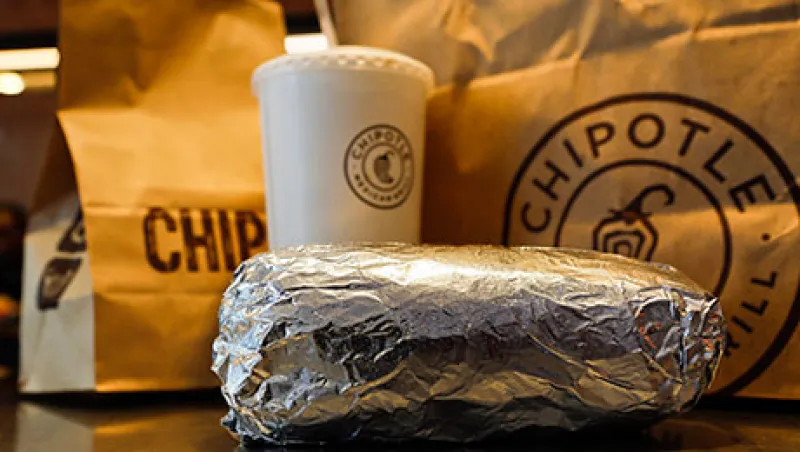When fast-casual restaurant operators and investors want to know the next big thing in their industry, they often look to Chipotle Mexican Grill. The Denver-based food chain, renowned for its burritos and guacamole, has long been seen as a barometer for the industry. Chipotle may not have been the first to employ an assembly-line style of food production combined with sustainably sourced ingredients and a fresh and healthy vibe, but since opening in 1993 as one of the first fast-casual restaurants, it has been the most successful. So when the chain announced last month that it was shaking things up again by removing all genetically modified organisms (GMOs) from its menu and launching delivery in more than 60 urban areas, burrito fans and competitors alike took notice.
“Chipotle has really been a leader in the changing way that people think about fast food,” says Mitchell Roth, president of Colorado Springs–based Southern Concepts Restaurant Group, who has taken many cues from Chipotle in the design of his Southern Hospitality BBQ chain.
That attitude shift — from viewing fast food only as cheap but tasty empty calories and chemicals to accepting a spectrum of instant gratification that also includes things like Chipotle’s burrito bowls and Panera Bread’s new quinoa offerings — has been fueled by the growing purchasing power of Millennials, who report being more comfortable than their parents with paying a bit more for fast food that seems fresher, healthier and more humane.
The fast-casual sector is growing more quickly than any other part of the restaurant industry — fast-casual chains increased annual sales by 12.8 percent in 2014, continuing a decade-long trend, according to research firm Technomic — but the realities of the restaurant industry make promising a full commitment to fair trade and to ethically sourced, fresh, healthy, organic and non-GMO ingredients prohibitively expensive for most chains. Yet Chipotle has created customer loyalty based from the very beginning on the “healthy” and “sustainable” buzzwords, which analysts and competitors alike say has allowed it to grow more quickly and take more risks than many of its peers.
“When you’re a company like Chipotle with a [nearly $20 billion] market cap, you can throw your weight around a little bit,” says Roth. “Their account is so meaningful to vendors that I doubt [removing GMOs] will touch their food cost, which is the reason a lot of companies wouldn’t go the organic route right out of the gate.”
It may seem like a gimmick — and there may be a lot of questions about the science behind it — but the non-GMO decision is a natural progression for Chipotle. Chairman and co-CEO Steve Ells started the chain in an effort to bring his fine dining training to the average burrito craver and quickly became disillusioned by how industrialized most fast food ingredients were. In 2001 Chipotle began avoiding meat from animals fed with hormones. Experts believe that the latest step, to remove GMOs, might do more than pull wary Millennials into Chipotle’s locations; the company’s power in the market could allow it to significantly change the way fast-casual dining operates.
“Chipotle is going to use their purchasing power to drive home those ethical values, and once that’s recognized by the consumer, all of a sudden there will be changes in consumer perception of other brands, and that really forces other brands to fall in line,” says Roth. In fact, Panera announced Monday that it would remove a long list of artificial ingredients from its own offerings.
The same will likely be true for the delivery trend, though Chipotle’s pioneering position in that realm seems less obvious. Burritos don’t tend to travel as well as boxed pizza or Styrofoam containers of General Tso’s chicken. But home delivery of everything from soap to groceries is becoming a necessity for the coveted Millennial demographic, especially in the urban areas where Chipotle and other fast-casual restaurants are battling hardest for their dollars. Twenty-five percent of global respondents to a recent Nielsen survey said they order groceries online for delivery at home.
With the advent of Amazon and more food-focused delivery services such as New York–based online grocery FreshDirect, Illinois-based grocery delivery service Peapod and San Francisco–based Postmates, which Chipotle teamed up with to launch delivery in 67 cities, the competition for consumers’ food dollars is getting fiercer.
“[Fast casual] chains are fighting the retailers for market share right now, and what’s most effective [in that fight] is delivery,” says Louis Biscotti, global practice leader for the food and beverage sector at New York–based accounting and advisory firm WeiserMazars.
Chipotle announced its foray into this particular fight quietly, during its first-quarter earnings call on April 21. Technically, customers could use Postmates to order Chipotle before the announcement, but the companies now have a newer, easier-to-use app interface and are actively marketing the service. It’s not cheap, however: Whereas ordering your favorite takeout through Seamless or GrubHub rarely includes a delivery fee or service charge, ordering Chipotle via Postmates will tack on at least $5 for delivery and a 9 percent service charge. And there have already been some hiccups, likely because of the fact that Postmates orders don’t go directly to Chipotle’s kitchens but to independent contractors working for Postmates who then stand in line and place your order the same way you would if you had entered a restaurant.
But consumers — particularly Millennials — have shown themselves willing to deal with worse in exchange for a bit of convenience or novelty. Chipotle is counting on this mentality, and experts say if it works, competitors will closely follow.
“If Chipotle is in front of the curve as the first to do delivery and remove GMOs, I think they’ll be able to steal some market share,” says Biscotti. “But I would not be surprised to see others following very quickly.”






